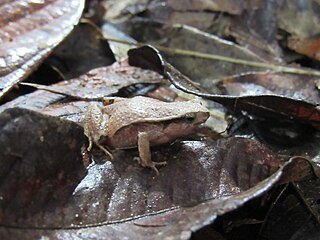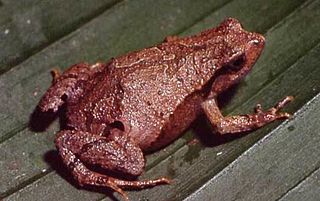The yellow-spotted brush-furred rat is a species of rodent in the family Muridae found in Angola, the Democratic Republic of the Congo, Ethiopia, Kenya, Malawi, Mozambique, South Sudan, Tanzania, and Zambia. Its natural habitats are subtropical or tropical moist lowland forest, subtropical or tropical moist montane forest, and subtropical or tropical high-altitude grassland. The population in Ethiopia is isolated and can be found at high altitudes up to 4,500 m above sea level.

Osornophryne antisana, the Napo plump toad, is a species of toad in the family Bufonidae. It is endemic to Ecuador. Its natural habitats are subtropical or tropical moist montane forests, subtropical or tropical high-altitude shrubland, and subtropical or tropical high-altitude grassland. It is threatened by habitat loss.
Gastrotheca espeletia, also known as the north shore marsupial frog is a species of frog in the family Hemiphractidae. It is found in Colombia and Ecuador. Its natural habitats are subtropical or tropical moist montane forests, subtropical or tropical high-altitude shrubland, subtropical or tropical high-altitude grassland, rivers, freshwater marshes, and intermittent freshwater marshes. It is threatened by habitat loss.
Physalaemus albifrons is a species of frog in the family Leptodactylidae. It is endemic to Brazil. Its natural habitats are subtropical or tropical moist lowland forests, dry savanna, moist savanna, subtropical or tropical dry shrubland, subtropical or tropical moist shrubland, and intermittent freshwater marshes. It is threatened by habitat loss.

Physalaemus atlanticus is a species of frog in the family Leptodactylidae. It is endemic to Brazil. Its natural habitats are subtropical or tropical moist lowland forests, freshwater marshes, and intermittent freshwater marshes.

Physalaemus biligonigerus is a species of frog in the family Leptodactylidae. It is found in Argentina, Bolivia, Brazil, Paraguay, and Uruguay. Its natural habitats are subtropical or tropical dry forests, temperate shrubland, subtropical or tropical dry shrubland, subtropical or tropical moist shrubland, temperate grassland, subtropical or tropical dry lowland grassland, subtropical or tropical seasonally wet or flooded lowland grassland, freshwater lakes, intermittent freshwater lakes, freshwater marshes, sandy shores, arable land, pastureland, plantations, rural gardens, urban areas, heavily degraded former forest, water storage areas, ponds, irrigated land, seasonally flooded agricultural land, and canals and ditches.
Physalaemus bokermanni is a species of frog in the family Leptodactylidae. It is endemic to Brazil. Its natural habitats are subtropical or tropical moist lowland forests and intermittent freshwater marshes. It is threatened by habitat loss.

Physalaemus caete is a species of frog in the family Leptodactylidae. It is endemic to Brazil. Its natural habitats are subtropical or tropical moist lowland forests and intermittent freshwater marshes. It is threatened by habitat loss.

Physalaemus centralis is a species of frog in the family Leptodactylidae. It is found in Bolivia, Brazil, and Paraguay. Its natural habitats are moist savanna, subtropical or tropical moist shrubland, subtropical or tropical seasonally wet or flooded lowland grassland, freshwater marshes, and intermittent freshwater marshes. It is threatened by habitat loss.

Physalaemus crombiei is a species of frog in the family Leptodactylidae. It is endemic to Brazil. Its natural habitats are subtropical or tropical moist lowland forests and intermittent freshwater marshes. It is threatened by habitat loss.

Physalaemus cuqui is a species of frog in the family Leptodactylidae. It is found in Argentina, Bolivia, and possibly Paraguay. Its natural habitats are subtropical or tropical dry forests, subtropical or tropical dry shrubland, subtropical or tropical moist shrubland, intermittent freshwater marshes, arable land, pastureland, ponds, irrigated land, and canals and ditches.

Physalaemus cuvieri is a species of frog in the family Leptodactylidae. It is found in Argentina, Brazil, Paraguay, and possibly also Bolivia, Guyana, Uruguay, and Venezuela. Its natural habitats are subtropical or tropical moist lowland forests, moist savanna, subtropical or tropical dry lowland grassland, subtropical or tropical seasonally wet or flooded lowland grassland, intermittent freshwater lakes, intermittent freshwater marshes, arable land, pastureland, plantations, rural gardens, urban areas, heavily degraded former forest, ponds, irrigated land, seasonally flooded agricultural land, and canals and ditches. It is threatened by habitat loss.
Physalaemus erythros is a species of frog in the family Leptodactylidae. It is endemic to Brazil. Its natural habitats are subtropical or tropical moist shrubland, subtropical or tropical high-altitude grassland, intermittent freshwater marshes, and rocky areas. It is threatened by habitat loss.

Physalaemus lisei is a species of frog in the family Leptodactylidae. It is endemic to Brazil. Its natural habitats are subtropical or tropical moist lowland forests, moist savanna, and intermittent freshwater marshes. It is threatened by habitat loss.
Physalaemus maximus is a species of frog in the family Leptodactylidae. It is endemic to Brazil. Its natural habitats are subtropical or tropical moist montane forests, swamps, and intermittent freshwater marshes. It is threatened by habitat loss.

Physalaemus nanus is a species of frog in the family Leptodactylidae. It is endemic to Brazil. Its natural habitats are subtropical or tropical moist lowland forests, intermittent freshwater marshes, rural gardens, heavily degraded former forest, irrigated land, seasonally flooded agricultural land, and canals and ditches. It is threatened by habitat loss.
Physalaemus obtectus is a species of frog in the family Leptodactylidae. It is endemic to Brazil. Its natural habitats are subtropical or tropical moist lowland forests and intermittent freshwater marshes. It is threatened by habitat loss.
Physalaemus rupestris is a species of frog in the family Leptodactylidae. It is endemic to Brazil. Its natural habitats are subtropical or tropical moist montane forests and intermittent rivers. It is threatened by habitat loss.

Physalaemus spiniger is a species of frog in the family Leptodactylidae. It is endemic to Brazil. Its natural habitats are subtropical or tropical moist lowland forests, subtropical or tropical moist shrubland, intermittent freshwater lakes, and intermittent freshwater marshes. It is threatened by habitat loss.
Phyllopentas ledermannii is a species of plant in the family Rubiaceae. It is found in Cameroon and Nigeria. Its natural habitats are subtropical or tropical moist lowland forests, subtropical or tropical moist montane forests, and subtropical or tropical high-altitude grassland. It is threatened by habitat loss.











